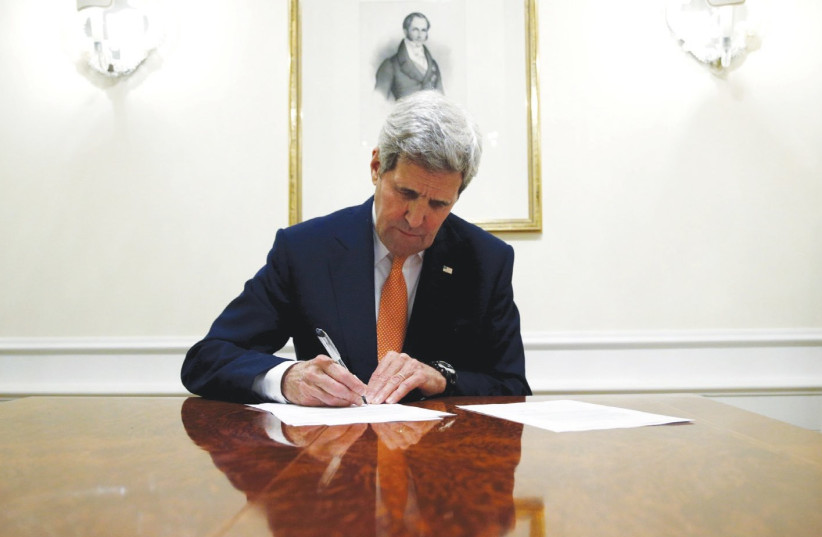When it comes to Iran, there seems to be almost a compulsion from both Democrats and Republicans to paint the other side as the complete source of all problems, and to argue that their own strategy has no downsides.
The latest example is Biden administration spokeswoman Jen Psaki’s statement: “None of the things we’re looking at now – Iran’s increased capability and capacity, the aggressive actions that they have taken through proxy wars around the world – would be happening if the former president had not recklessly pulled out of the nuclear deal with no thought as to what might come next.”
Is this all true? Did the Trump administration cause all of Iran’s terrorist and nuclear violations?
Not according to the facts.
The truth is that the Iran nuclear deal of 2015 never slowed the Islamic Republic’s terrorist activities in the Middle East, but actually expanded them, giving Iran a feeling of free action in Syria, Iraq, Yemen and other places because the Obama administration did not want to confront the ayatollahs and risk the deal.
The truth is also that Qasem Soleimani, chief of the Islamic Revolutionary Guard Corps Quds Force, was pursuing his dream of a giant Shi’ite land bridge across the Middle East long before Trump pulled out of the deal – something that people forget did not happen until May 2018.
In fact, only a few days before the implementation day of the nuclear deal on January 16, 2016, the Islamic Republic arrested around a dozen US sailors for no reason other than to show it could get away with more, now that the deal was signed.

Not too long into the deal, Iran twice violated the heavy-water limits that had been set.
Tehran was also firing long-range ballistic missile tests throughout the term of the deal, with little or no reaction from the Obama administration.
Until January 31, 2018, when the Mossad grabbed Iran’s secret nuclear archives, we also did not know (though many suspected) that the ayatollahs were concealing active and current nuclear weaponization files.
And of course, no one in the Obama administration had a real answer about how they would stop Iran from developing nuclear weapons once the deal expires in 2025 and 2030.
So no, not all of the world’s problems with Iran came from Trump’s pulling out of the deal.
A BETTER and more nuanced question is whether Trump’s pulling out of the deal has placed the US and Israel in a better or worse position, given that he had no Plan B if his maximum pressure campaign did not succeed in getting Iran to agree to new nuclear concessions and to reduce its regional terrorism.
Here, there is plenty for which the former president can be blamed.
Just as the facts show that Trump did not create any of the problems Iran presents, the facts also say he did not solve any of those problems either.
From the American perspective, Iran certainly was more aggressive against US interests in various ways due to Trump’s combativeness than it was before he pulled out of the deal.
Also, the nuclear violations the Islamic Republic undertook following Trump’s pulling out of the deal and ending sanction waivers in May 2019 really were far worse than the smaller minor violations Tehran committed under the Obama administration.
The nuclear archives the Mossad found proved additional extensive weaponization moves by Iran in the past, but did not prove any current or ongoing new smoking-gun ones.
Iran really was following most of the nuclear deal when Trump pulled out, prematurely blowing some potential years of nuclear quiet as he did so.
No administration has really succeeded at getting the world’s biggest sponsor of terrorism to stop its ballistic missile tests.
So neither Obama nor Trump really solved the Iran problem, as both addressed some aspects while ignoring others. One could dismiss the inaccuracy in Psaki’s statement and focus on fair criticism she can make of Trump.
But the problem is the sunset clause. The nuclear expiration issue is even more serious now than it was when Obama inked the deal in 2015.
If Biden does a straight return to the JCPOA, key nuclear limits will be off in only three years and the rest in only eight years. And Iran now knows far more about how to quickly move forward in uranium enrichment than it knew in 2015.
While some of this is Trump’s fault for not having had a Plan B ready that would completely stop Tehran from developing advanced centrifuges, some of it was also Obama’s fault because the deal itself allowed continued experimentation with such centrifuges (even if only in small numbers.)
So Psaki and Biden can feel free to blame Trump for issues he missed and problems he did not solve – and possibly even exacerbated. However, they have not presented an answer as to how they will solve the Iranian nuclear problem in 2025/2030 or the regional terrorism issue, which basically never stopped.
